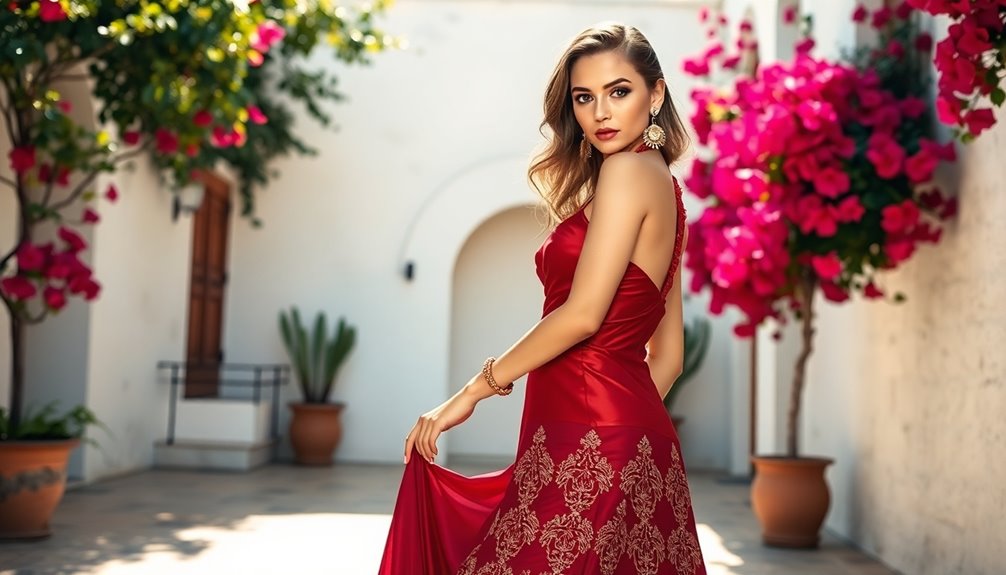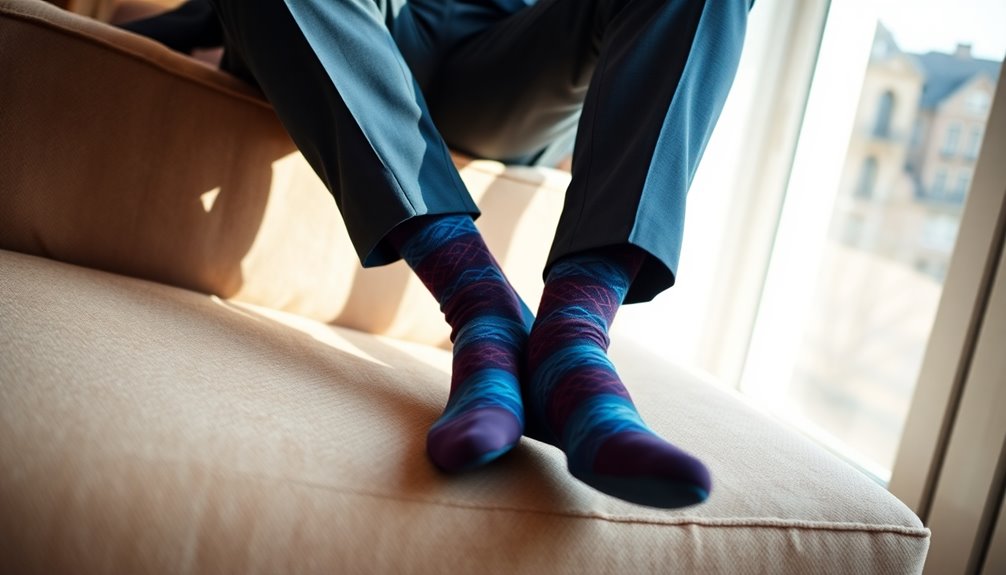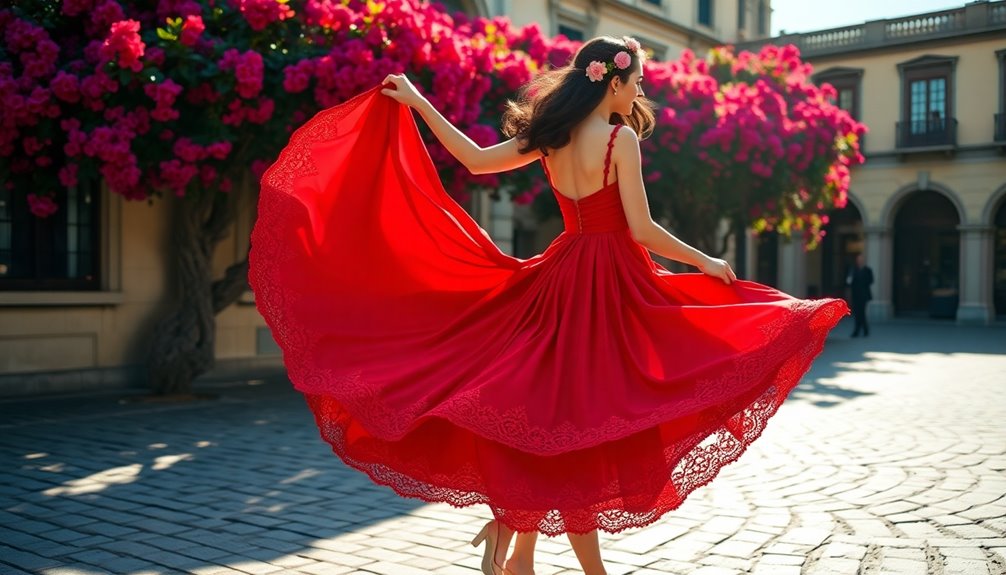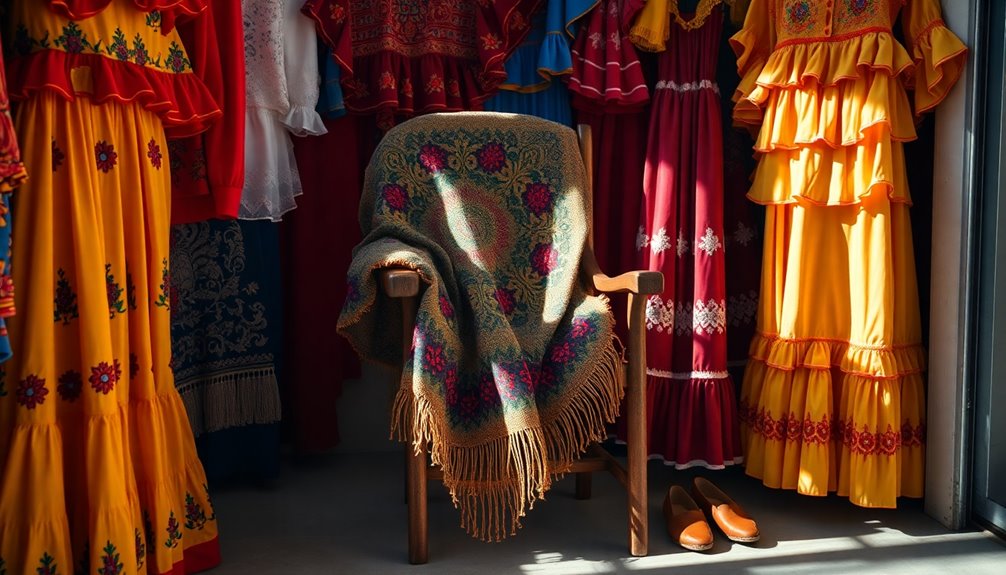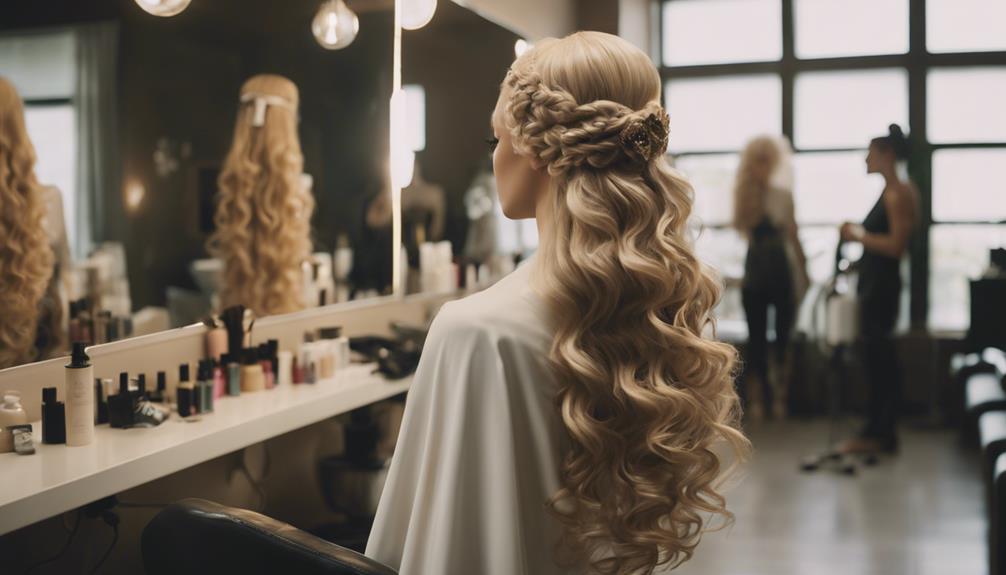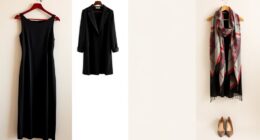Modern Spanish dress blends rich traditions with cutting-edge style. You'll notice how flamenco dresses and traje fallera inspire contemporary designs, emphasizing vibrant colors and intricate patterns. Designers like Rosa Clará and Palomo Spain breathe new life into classic silhouettes, using ruffles and voluminous shapes that capture movement and elegance. Accessories like mantillas and espadrilles enhance your look, adding cultural depth. Plus, the rise of sustainable practices is making these gorgeous outfits even more accessible. If you want to discover the latest trends and styling tips, there's plenty more to explore in the vibrant world of Spanish fashion.
Key Takeaways
- Modern Spanish dress combines traditional elements like ruffles and vibrant colors with innovative cuts, creating a chic and dynamic aesthetic.
- Signature silhouettes feature flared skirts and structured bodices, enhancing both visual appeal and movement, essential in contemporary designs.
- Designers like Rosa Clará and Palomo Spain successfully blend cultural heritage with modern fashion trends, appealing to a global audience.
- Sustainable practices, such as upcycling and natural dyeing, are increasingly adopted by Spanish brands, emphasizing eco-friendly fashion choices.
- Emerging labels and fashion icons celebrate Spanish heritage, showcasing traditional motifs through contemporary styles during events like Madrid and Barcelona Fashion Weeks.
Origin and historical background of the fashion trend/style
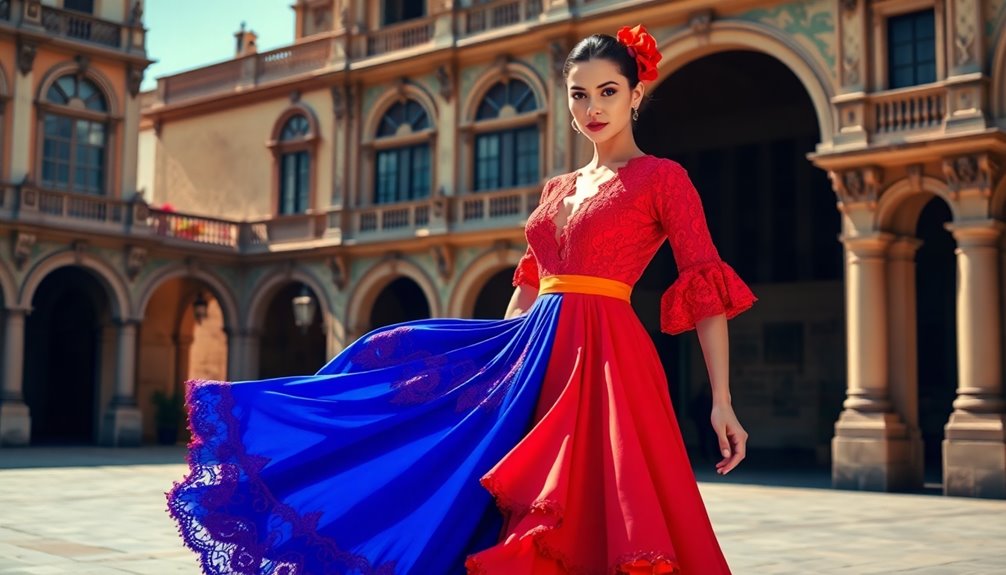
When you look at modern Spanish dress, you can see the impact of centuries of textile transformations.
From the Visigoth period to the Renaissance and into contemporary times, each cultural influence has shaped what you wear today.
This rich heritage blends seamlessly with modernity, creating a fashion landscape that honors the past while embracing innovative design.
Historical Textile Transformations
Spanish textiles have undergone remarkable transformations throughout history, shaping the country's distinctive fashion landscape. You can trace their origins back to Romanesque costumes that highlighted class distinctions through fabrics like brial and pellizón.
The Moorish conquest in the 8th century brought intricate patterns and luxurious textiles, which significantly influenced Spanish clothing styles and textile techniques. As you explore this evolution, you'll notice how these influences melded into what we now recognize as traditional dress.
In the 18th and 19th centuries, Galicia's thriving linen industry predominantly employed women, showcasing their craftsmanship. However, by the mid-19th century, external competition began to challenge this vibrant sector.
The late 20th century marked a revival spurred by brands like Inditex, who successfully combined traditional craftsmanship with an innovative spirit.
Trade routes enriched the fabric diversity available in Spain, enabling a fusion of cultural influences that continues to inspire modern designs. As you delve into Spanish fashion today, you'll see how these historical textile transformations inform contemporary aesthetics, creating a lasting dialogue between the past and present.
Cultural Heritage and Modernity
Cultural heritage and modernity in Spanish fashion intertwine beautifully, reflecting centuries of influence from various cultures. You'll notice how traditions from the Roman, Moorish, and Visigoth eras have shaped clothing styles and textiles over time. Iconic garments like the flamenco dress and traje fallera vividly showcase regional identities, emphasizing intricate craftsmanship and vibrant colors that define Spanish textiles.
The Renaissance era brought a significant shift, with opulent styles emerging among the royal court. Luxurious fabrics and elaborate designs from this period continue to inspire contemporary design today.
Designers like Rosa Clará exemplify this blend, successfully merging traditional elements with modern aesthetics. Their work revitalizes classic styles, making them appealing to today's consumers while preserving cultural heritage.
Additionally, the rise of fast fashion brands like Zara highlights the global influence of Spanish fashion. These brands incorporate traditional motifs and craftsmanship into their collections, bridging the gap between heritage and modern chic.
Key Characteristics

When you explore modern Spanish dress, you'll notice distinct signature silhouettes that flatter a variety of body types.
The vibrant textiles often blend earthy tones, creating a rich tapestry that reflects Spain's cultural diversity.
Don't forget to pay attention to the unique accessories that elevate these styles, adding an authentic touch to any outfit.
Signature Spanish Silhouettes
Emphasizing movement and elegance, signature Spanish silhouettes are defined by their dramatic lines and voluminous shapes. You'll often find flared skirts in flamenco dresses and structured bodices in Fallera costumes, both of which create a striking visual effect. These silhouettes enhance your natural grace, allowing you to feel both festive and fashionable.
A hallmark of traditional Spanish dress is the integration of ruffles, frills, and layered fabrics, which not only enrich the design but also contribute to an overall sense of celebration.
Contemporary Spanish fashion designers skillfully adapt these classic silhouettes using modern fabrics and innovative cuts, ensuring they resonate with today's style-savvy individuals.
You'll notice that many Spanish dresses feature a fitted waist paired with A-line or mermaid shapes, flattering a variety of body types while maintaining a feminine aesthetic.
The use of vibrant colors and intricate patterns, rooted in Spain's rich textile heritage, adds an eye-catching element to modern designs.
These key characteristics of signature Spanish silhouettes make them a captivating choice for any wardrobe, blending traditional artistry with contemporary flair.
Vibrant Textiles and Earthy Tones
Signature Spanish silhouettes not only capture the eye with their dramatic lines but also set the stage for the vibrant textiles and earthy tones that define modern Spanish dress.
You'll find that these vibrant textiles reflect Spain's rich history of intricate weaving and embroidery techniques, often crafted from materials like linen, silk, and cotton. The bold colors and textures create garments that aren't only visually striking but also deeply rooted in local artisanal practices.
Earthy tones have become increasingly popular, drawing inspiration from Spain's diverse landscapes. You might notice warm ochres, deep greens, and rich browns that evoke a sense of connection to nature.
This blend of earthy hues with vibrant textiles creates a balanced aesthetic, perfect for today's fashion-forward individual.
Additionally, traditional patterns, particularly those influenced by Moorish designs, are often fused with modern cuts, giving you a unique look that embodies both heritage and contemporary chic.
This ongoing trend not only appeals to a global audience but also reinforces cultural pride and identity through fashion. Embracing these elements allows you to celebrate Spain’s artistic legacy while keeping your style fresh and relevant. Spanish fashion elegance has a long history of influence and innovation, from the traditional flamenco dresses to modern designs by acclaimed Spanish designers. By incorporating elements of Spanish fashion elegance into your wardrobe, you are not only showcasing your appreciation for timeless style, but also adding a touch of sophistication to your look. Whether it’s through a pair of handcrafted leather shoes or a vibrant, embroidered shawl, embracing Spanish fashion elegance allows you to exude confidence and grace in every outfit.
Signature Spanish Accessories
Spanish accessories play a crucial role in enhancing your overall look, blending tradition with modern flair. When you think of signature Spanish accessories, the traditional mantilla often comes to mind—a stunning lace or silk veil that adds elegance and cultural depth, especially during religious events and festivals.
Pair this with espadrilles, the quintessential footwear crafted from canvas or cotton with esparto rope soles, and you'll embody a perfect mix of traditional craftsmanship and contemporary fashion trends.
Don't overlook vibrant shawls, known as mantones, which feature intricate embroidery and fringes. These aren't just practical but also immensely stylish, perfect for flamenco performances or cultural celebrations.
Bold statement jewelry, often made from silver or colorful ceramics, can accentuate your outfit, showcasing regional craftsmanship and artistic influences.
Lastly, high-quality leather goods like handbags and belts are essential. These pieces highlight artisanal techniques that marry functionality with fashionable appeal.
Modern Interpretation
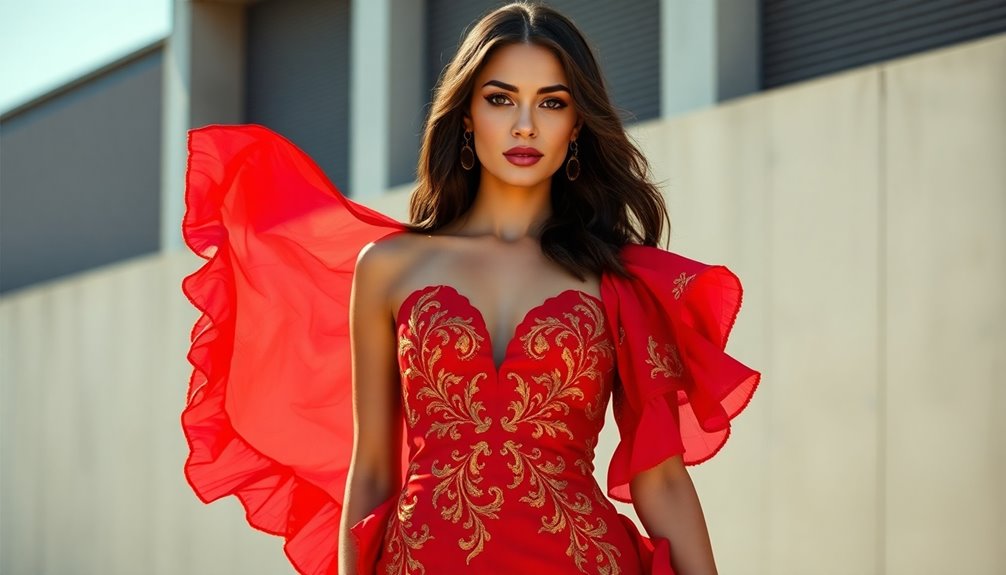
When you explore modern Spanish dress, you'll notice a strong emphasis on sustainable fashion practices that reflect a growing awareness of environmental impact.
Emerging Spanish fashion labels are leading the charge, blending innovation with cultural heritage to create unique styles.
Plus, fashion icons in Spain are championing these trends, influencing both local and global fashion scenes.
Sustainable Fashion Practices
In today's fashion landscape, sustainability has become a vital part of the industry's evolution. You'll notice that Spanish brands are increasingly committing to sustainable fashion, with Zara aiming to use 100% sustainable cotton and linen by 2025. This shift is largely driven by eco-conscious consumers like you, who are demanding more artisanal fabrics and handmade garments.
Between 2019 and 2022, the market for sustainable fashion in Spain surged by 29%, showcasing your preference for eco-friendly choices.
Many Spanish designers revive traditional textile techniques, such as hand-weaving and natural dyeing, to reduce environmental impact while keeping cultural heritage alive. Thanks to the rise of e-commerce, you can easily access pre-owned and sustainably produced garments, playing a crucial role in the circular fashion economy.
These platforms make it simpler for you to embrace eco-friendly styles without sacrificing chicness. Collaborative efforts among designers, artisans, and environmental organizations focus on minimizing waste.
Upcycling vintage garments is becoming popular, allowing you to wear a piece of history while contributing to sustainable practices. This fusion of tradition and modernity is redefining the way you approach fashion.
Emerging Spanish Fashion Labels
Over the past few years, emerging fashion labels have been redefining the landscape of modern Spanish style. Brands like Palomo Spain and Ailanto beautifully blend traditional craftsmanship with contemporary aesthetics. Their collections feature vibrant colors and intricate patterns that pay homage to Spain's rich textile heritage.
You'll find A.W.A.K.E. Mode, founded by Natalia Alaverdian, drawing inspiration from Spanish culture while emphasizing innovative silhouettes and sustainable practices—truly a fresh take on haute couture.
Labels such as Sita Murt and Yolancris have emerged as frontrunners in modern bridal wear, combining traditional techniques with minimalist designs that resonate with contemporary brides seeking elegance and authenticity.
Meanwhile, designers like Agatha Ruiz de la Prada inject playful elements and bold prints into their collections, illustrating a modern twist on traditional Spanish motifs.
Additionally, the rise of sustainable labels like Ecoalf showcases a commitment to eco-friendly materials and practices, appealing to a growing market of environmentally-conscious consumers.
These emerging Spanish fashion labels embody new trends that not only celebrate individuality but also preserve the essence of Spain's vibrant fashion heritage.
Fashion Icons in Spain
Spanish fashion icons have emerged as powerful figures who skillfully blend traditional elements with contemporary styles, redefining what it means to wear Spanish fashion today.
You'll notice how stars like Rosalía and Penélope Cruz incorporate vibrant colors and cultural motifs into their wardrobes, making bold statements that pay homage to Spain's rich heritage. Their influence extends to events like Las Fallas festival, where traditional attire meets modern flair, showcasing the dynamic nature of Spanish fashion.
Designers such as Balenciaga and Custo Barcelona are at the forefront, merging classic Spanish aesthetics with modern silhouettes and materials.
You can see the influence of flamenco dance costumes in the bold ruffles and intricate embroidery featured in both haute couture and streetwear collections. Fashion weeks in Madrid and Barcelona spotlight emerging talents who reinterpret traditional garments, ensuring they resonate with today's audience.
Social media amplifies the visibility of these fashion icons in Spain, allowing a global audience to connect with and adopt their modern interpretations of traditional Spanish dress.
Through their artistry, they create a vibrant tapestry that celebrates the past while embracing the future of fashion.
Styling Tips
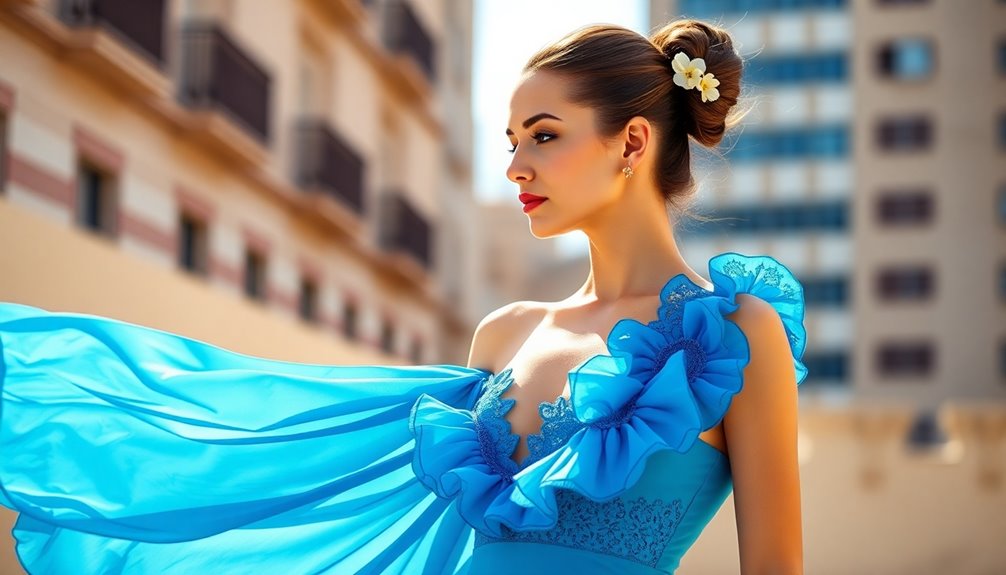
When styling your outfit, think about incorporating essential Spanish accessories that showcase craftsmanship and flair.
A flamenco-inspired top pairs beautifully with modern silhouettes, creating a chic look that stands out.
Don't forget to layer textures and patterns to add depth and celebrate cultural heritage in your ensemble.
Essential Spanish Accessories
There's something undeniably captivating about incorporating essential Spanish accessories into your wardrobe. These accessories can effortlessly elevate your style, blending tradition with contemporary flair.
Start with colorful shawls, or "mantones," adorned with intricate embroidery; they add a beautiful touch to any outfit. Pair one with basic pieces for a striking contrast.
Next, consider wide-brimmed hats like the "sombrero cordobés." Not only do they offer sun protection during outdoor events, but they also provide a chic statement that's perfect for festivals.
Don't forget the power of statement earrings, inspired by flamenco aesthetics. Bold colors and elaborate designs can instantly enhance your look, making a significant impact without overwhelming your outfit.
Finally, traditional espadrilles are a must-have. Their canvas and jute construction offers both comfort and style, making them ideal for casual outings or dressier occasions.
Mix and match these essential accessories to create a unique ensemble that reflects your personality while honoring Spanish culture.
Embrace the charm and sophistication of Spanish fashion, and watch how these pieces transform your wardrobe.
Flamenco-Inspired Ensemble Suggestions
To create a stunning flamenco-inspired ensemble, focus on vibrant fabrics that showcase bold polka dots or floral prints, reminiscent of traditional flamenca dresses. These lively patterns are perfect for capturing the essence of flamenco culture.
Incorporate ruffled elements into your outfit; layering ruffles on skirts or blouses adds movement and fluidity, mimicking the dance's graceful style.
Choose fitted silhouettes that accentuate your waist and enhance your hourglass figure, similar to the flattering lines of flamenca dresses. This will help you embrace femininity while staying true to the flamenco theme.
Accessorizing is crucial, so don't shy away from statement pieces. Large hoop earrings, colorful flower hair clips, or elegant mantones (shawls) can elevate your look and add a contemporary twist to the traditional aesthetic.
Finally, complete your ensemble with a pair of ankle boots or classic flamenco shoes (zapatos de flamenco) featuring a sturdy heel. This ensures comfort while maintaining the authentic vibe of flamenco style.
Embrace this vibrant, dynamic look to truly stand out and celebrate the rich heritage of Spanish fashion.
Layering Textures and Patterns
Building on the vibrant elements of flamenco-inspired ensembles, layering textures and patterns can elevate your modern Spanish outfit even further. Start by pairing a delicate lace blouse with a structured wool blazer, which adds depth and sophistication. This combination reflects Spain's rich textile heritage while keeping your look chic.
Incorporating traditional fabrics like linen or silk in contemporary silhouettes creates a seamless blend of historical craftsmanship and modern aesthetics. For special events, try layering vibrant flamenco patterns with muted pieces to strike a perfect balance.
Don't shy away from mixing prints—combining floral designs with geometric patterns can result in a dynamic, fashion-forward ensemble. Brands like Zara offer affordable options that allow you to experiment without breaking the bank.
Accessories play a crucial role too; consider adding an embroidered shawl or a patterned scarf to enhance your layered look. These elements draw on regional influences while adding a contemporary twist.
Shopping Guide
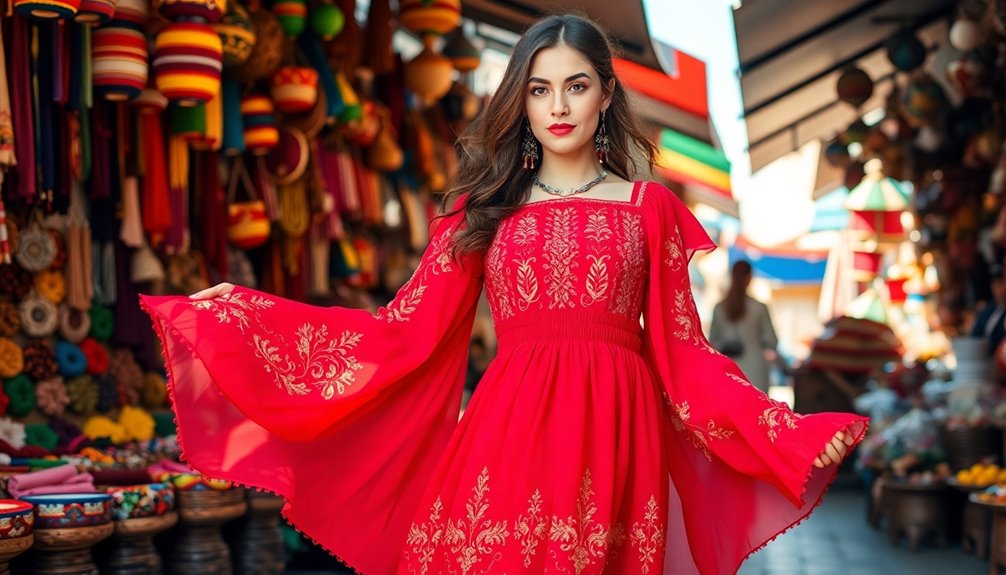
When it comes to shopping for modern Spanish dress, you'll find an exciting blend of tradition and contemporary style. Start your journey by exploring local boutiques and online platforms like Rosa Clara, where you can discover bridal and formal wear that beautifully merges traditional craftsmanship with modern aesthetics.
Don't forget to seek out sustainable fashion options. Choose brands committed to eco-friendly materials and practices, reflecting the growing trend in the Spanish fashion industry.
Seasonal sales during events like Madrid Fashion Week and Barcelona Bridal Fashion Week are perfect opportunities to score unique pieces at competitive prices.
If you're on a budget or want to make a more eco-conscious choice, consider secondhand shopping for wedding dresses and formal attire. Platforms like Borrowing Magnolia offer preowned designer options that can save you money while reducing environmental impact.
Lastly, research regional specialties in traditional attire, such as flamenco dresses or traje fallera. These pieces not only celebrate Spain's rich cultural heritage but also incorporate contemporary styles, making them a perfect addition to your wardrobe.
Happy shopping!
Upcycling Vintage Spanish Fabrics
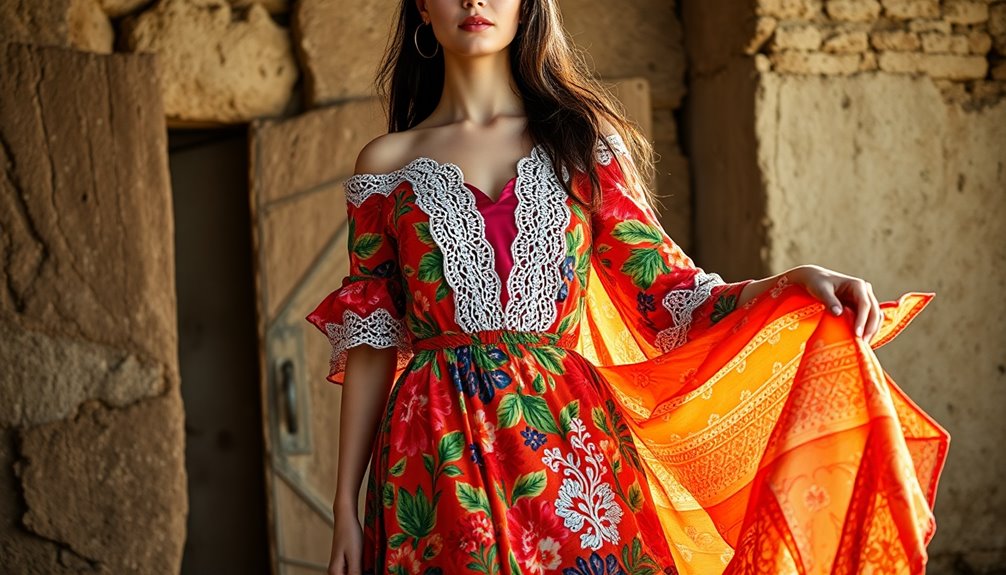
When you think about upcycling vintage Spanish fabrics, consider the endless possibilities of fabric remnants for your next craft project.
You can reimagine those beautiful patterns into new creations, giving them a fresh life while celebrating their history.
This not only helps reduce waste but also connects you to the rich tapestry of Spanish culture.
Fabric Remnants Craft Projects
Creativity flourishes when you dive into fabric remnants craft projects, especially with vintage Spanish fabrics. By upcycling these treasures, you not only preserve the rich heritage of traditional craftsmanship but also help combat the alarming fact that about 85% of textiles end up in landfills each year.
Imagine transforming remnants into one-of-a-kind home decor items or stylish fashion accessories that showcase the vibrant colors and intricate patterns typical of these fabrics. Techniques like patchwork and quilting allow you to honor the labor-intensive embroidery and weaving traditions of regions like Galicia while creating something entirely new.
Incorporating sustainable practices is also key; consider using eco-friendly adhesives and non-toxic dyes in your projects. This approach aligns perfectly with the growing trend of environmentally conscious crafting. Additionally, these projects can serve as a way to enhance children's cognitive development through hands-on creative activities.
As you participate in these fabric remnants craft projects, you're not just being creative—you're contributing to the revival of traditional Spanish textiles. This effort promotes their cultural significance while embracing modern design aesthetics, making your creations not only beautiful but meaningful.
Reimagining Vintage Fabric Patterns
Reimagining vintage fabric patterns breathes new life into traditional Spanish textiles, allowing you to create modern garments that celebrate their rich heritage. By upcycling vintage materials like linen and silk, you're not just crafting unique pieces; you're preserving the artistry and craftsmanship that define Spanish culture.
This practice significantly reduces textile waste, addressing the staggering 400 lbs of garbage often generated by events like weddings.
When you work with vintage Spanish fabrics, you'll discover intricate patterns and vibrant colors that reflect the regional influences of Spain. These elements can be seamlessly integrated into contemporary designs, ensuring the cultural significance remains intact.
Designers often draw inspiration from traditional attire, such as flamenco dresses, incorporating ruffles and bold patterns into chic, modern styles.
The growing demand for artisanal and handmade textiles aligns perfectly with this revival. Many consumers are looking for eco-friendly fashion options that stand out, and upcycled vintage fabrics offer just that.
Cultural Impact
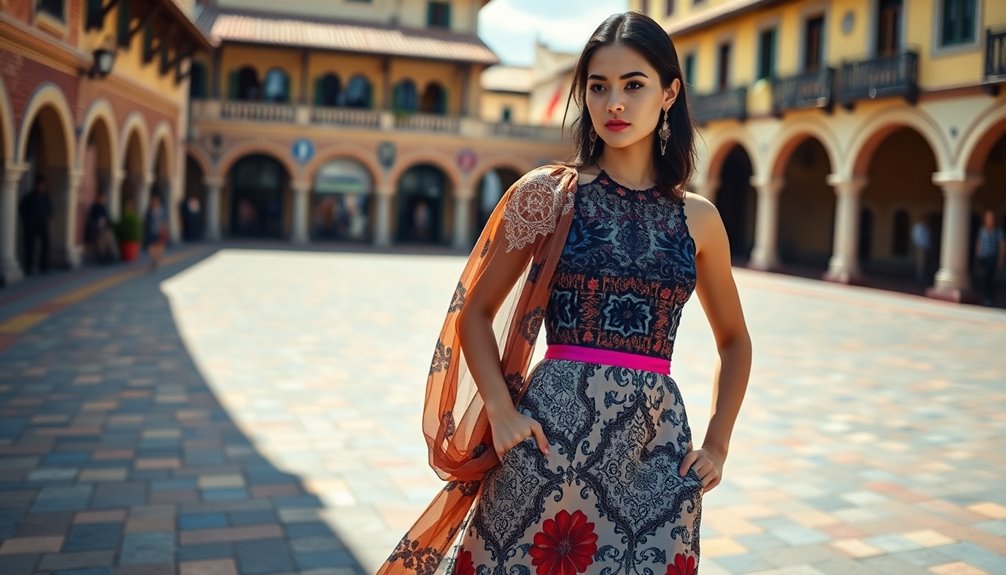
Spanish films have a unique way of shaping fashion trends, showcasing styles that resonate with audiences both locally and globally.
You'll notice how fashion activism in Spain is rising, with designers and influencers pushing for sustainability and cultural representation in their work.
This intersection of cinema and fashion not only highlights Spain's rich heritage but also drives modern movements within the industry.
Spanish Films and Fashion Trends
While exploring the vibrant world of cinema, you'll discover how films steeped in Spanish culture bring traditional attire to the forefront, shaping contemporary fashion trends. Iconic films like "Volver" and "Carmen" vividly showcase flamenco dresses and Fallera costumes, highlighting Spain's rich cultural heritage. These striking depictions not only capture the beauty of traditional garments but also inspire contemporary designers to incorporate these elements into their collections, boosting global interest in Spanish fashion.
Fashion in Spanish cinema serves as a powerful storytelling device, enhancing character development and conveying cultural significance. As a viewer, you can appreciate how each costume tells a story, elevating the status of traditional clothing.
Collaborations between filmmakers and fashion designers further merge cinematic artistry with modern trends, resulting in limited-edition collections that appeal to a broader audience.
In recent years, the revival of interest in traditional Spanish styles can be traced back to these cinematic portrayals. This resurgence contributes to a renewed appreciation for artisanal craftsmanship and sustainable fashion practices in the industry, making it an exciting time to explore the intersection of film and fashion in Spain.
Fashion Activism in Spain
Fashion activism in Spain is increasingly shaping the cultural landscape, with many designers and brands championing sustainable practices and ethical labor conditions. In response to the fashion industry's significant contribution to global carbon emissions, these creatives are driving change.
Initiatives like "Fashion Revolution" empower you to question the origins of your clothing, fostering responsible consumption and transparency in the supply chain.
You might notice a surge in local and artisanal brands that emphasize traditional craftsmanship and sustainable materials. This shift reflects your desire for unique products that honor cultural heritage.
Moreover, Spanish fashion campaigns are addressing vital social issues, such as gender equality and body positivity. Brands are showcasing diverse models and promoting inclusivity, making fashion more representative of society.
Events like Madrid Fashion Week play a crucial role by spotlighting designers committed to eco-friendly practices, elevating the conversation around sustainable fashion.
Frequently Asked Questions
What Are Traditional Spanish Dresses Called?
Traditional Spanish dresses have specific names that reflect their regional origins and cultural significance.
For instance, you'll encounter the "Traje de flamenca," worn in Andalusia, and the "Traje fallera," which is popular during Valencia's Las Fallas festival.
If you're in the Basque Country, you'll see the "Baserritarra," while Madrid showcases the "Traje chulapo."
Each dress not only represents fashion but also embodies the unique heritage and pride of its region.
What Is Popular Clothing in Spain?
In Spain, you'll find a vibrant mix of popular clothing styles. During festivals, many people wear the traje de flamenca, with its bright colors and ruffles, or the traje fallera in Valencia, known for its elaborate designs.
Younger generations often embrace casual streetwear, favoring brands like Zara and Mango. Additionally, you'll notice a rise in sustainable fashion, as many Spaniards prioritize eco-friendly practices while staying stylish.
What Is the Traditional Dress for Men in Spain?
When you explore traditional dress for men in Spain, you'll find rich regional variations.
In Andalusia, you might see the traje corto during festivals, while the Basque Country showcases the baserritarra with its classic white shirt and beret.
In Madrid, the chulapo outfit features fitted trousers and a checkered shirt.
Don't miss the traje fallero in Valencia, adorned with vibrant silk and a barretina, highlighting Spain's diverse cultural heritage.
What to Wear to a Spanish Festival for Females?
When you're heading to a Spanish festival, consider vibrant flamenco dresses with ruffles and polka dots for a festive touch.
If you're attending Las Fallas, the traje fallera, with its voluminous skirts and lace, is a beautiful choice.
Don't forget to accessorize with flowers in your hair and traditional jewelry.
Comfortable espadrilles or stylish sandals will keep you ready for dancing and walking, blending tradition with your unique style.
Enjoy the celebration!
